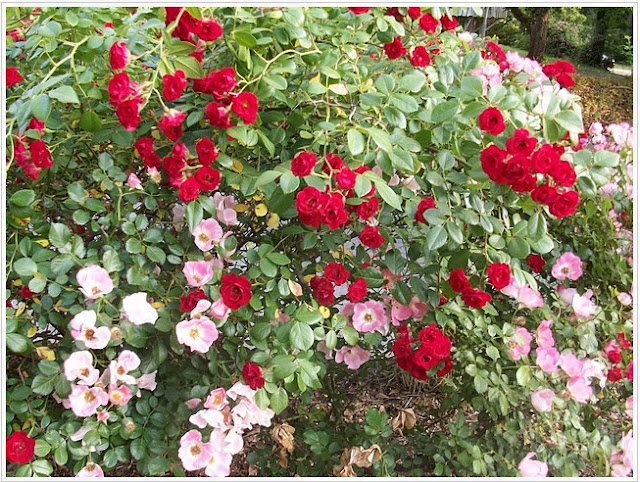Roses – Messages of Love
'Wait not till tomorrow; Gather the roses of today'
-Pierre de Ronsard
Come, join me in a lovely cup of Rose Tea -
a blend of rose petals, valerian root and citrusy herbs - while we
contemplate the queen of flowers - the rose, heirloom roses
and some of the history of the Language of Flowers.
No wonder the rose is considered a messenger of love.
In the 19th Century there were over 6,000 different kinds.
According to Thomas Christopher,
author of In Search of Lost Roses,
‘not all these roses were available at a given time, but still, a century ago gardeners took for granted that they would have access to roses of all sorts of sizes and colors, from tiny five-petalled roses very little from the wild species, to huge, petal-packed puffs as much as six inches in diameter’.
Thomas took note that in the beginning of the 20th Century, nurseries consolidated and rose producers were reduced to a few giant firms limiting themselves only to the best sellers.
 |
| Wild Ginger |
While restoring a garden in New York, Thomas discovered a garden plan that included a number of roses with names he was not familiar with. Thus began his search for Lost Roses and the encounter with people and organizations out to preserve historic roses found in old cemeteries, farmhouses and old towns.
'Roses outlive both houses and gardeners. Keep your eyes open
whenever you find yourself any place time has passed by'.
To imagine the long hours searching and then identifying
heirloom roses, to me is truly a labor of love.
"For the flowers have their angels... For there is a language of flowers. For there is a sound reasoning upon all flowers. For elegant phrases are nothing but flowers."
Christopher Smart – Jubilate Agno
Over the years, many authors have written and listed the language of flowers. Two women are credited with introducing the language of flowers to Europe, seigneur Abry de la Mattraye and Lady mary Wartley Montagu.
The language of flowers originated in oriental countries for instance Turkey. Initially, they were not intended as they sometimes were used, for a romantic purpose. As best can be surmised, the language of flowers was for the purpose of memorization. The name of the plant or flower was associated with another with similar sound –
"Its spirit consists not, as might naturally be supposed, in the connection which fancy may trace between particular flowers and certain thoughts and feelings. Such an idea never entered the heads of the fair inventresses of the oriental language of flowers.
They have contented themselves with merely taking a word, which may happen to rhyme with the name of any particular flower or fruit, and then filling up the given rhyme with some fanciful phrase corresponding with its signification... Thus, for instance, the word Armonde (Pear) rhymes among other words with omonde (hope); and this rhyme is filled up as follows: Armonde - Wer banna bir omonde;" (Pear - Let me not despair.)."
The book Le Langage des Fleurs by Charlotte de Latour has been credted to be the harbinger of an abundance of language of flowers books. Thereby a number of the lists created agreed whether they originated from France, England and America.
'I sent thee late a rosy wreath, Not so much honoring thee,
As givit it a hope that there It could not withered be'.
-Ben Johnson
We are the beneficiaries of such rich history, the propagation of flowers, of roses, the creations of gardens and the ascribing names and meaning to all flowers. Today, we view the language of the rose, especially a red rose – as a message of love. Whether initially intended as in the several Languages of Flowers books, I’ll take the romantic view and meaning any time.
Wishing you the most Delightsome day,













